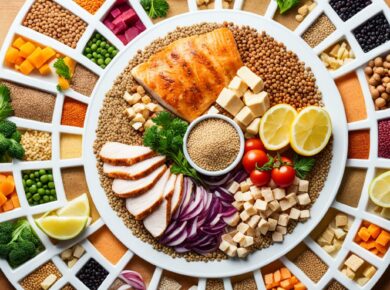Welcome to the first section of our weight loss journey! If you’re embarking on a weight loss journey, it’s important to start with a clear goal in mind. Setting a weight loss goal can give you direction and motivation as you work towards a healthier weight. In this section, we’ll explore the importance of setting realistic goals and tracking your progress throughout your weight loss journey.
Research has shown that setting specific goals can significantly increase your chances of success. The National Heart, Lung, and Blood Institute (NHLBI) recommends starting with a goal of losing 5-10% of your current weight. This initial goal can set the foundation for further progress. The Centers for Disease Control and Prevention (CDC) suggests aiming for a steady and gradual weight loss of 1-2 pounds per week. Remember, weight loss is a journey, and achieving a healthier weight takes time and dedication.
By setting a weight loss goal, you give yourself something to strive for and measure your progress against. Having a specific target can help keep you motivated and focused on making healthier choices. Whether it’s fitting into your favorite pair of jeans or improving your overall well-being, setting a weight loss goal can be a powerful tool in your journey towards a healthier you.
Next, let’s explore the importance of setting the right goals for achieving weight loss success. But first, take a look at the image below to stay motivated and inspired throughout your weight loss journey!
The Importance of Setting the Right Goals
Setting the right goals is crucial for achieving weight loss success. Research studies have shown that individuals who set higher goals and are motivated by health and fitness are more likely to stick with their weight loss efforts.
When it comes to goal setting, it’s important to keep a few key factors in mind. Firstly, your goals should be specific. Instead of saying “I want to lose weight,” set a specific target like “I want to lose 10 pounds.” This specificity gives you something concrete to work towards.
Secondly, your goals should be realistic. It’s important to set attainable goals that you can realistically achieve. Losing 10 pounds in a week may not be realistic or healthy, but losing 1-2 pounds per week is both achievable and sustainable.
Lastly, your goals should be forgivable. This means allowing for setbacks and not beating yourself up if you don’t meet your goals every time. Weight loss is a journey, and there will be ups and downs along the way. It’s important to be kind to yourself and stay motivated even when things don’t go as planned.
Setting the right goals sets you up for weight loss success. By being specific, realistic, and forgivable in your goal setting, you’ll be more likely to stay on track and achieve the weight loss results you desire.
How to Set Effective Monthly Weight Loss Goals
When it comes to achieving your weight loss goals, setting monthly targets can be a powerful strategy. By focusing on smaller, achievable milestones, you can stay motivated and track your progress more effectively. Here are some tips on how to set effective monthly weight loss goals:
- Make your goals specific: Instead of simply aiming to lose weight, set specific goals that are measurable and actionable. For example, instead of saying “I want to lose weight,” you could set a goal to “walk for 30 minutes daily, five times a week.”
- Be realistic: It’s important to set goals that are attainable within a month’s time frame. Consider your current fitness level, lifestyle, and other commitments when setting your weight loss targets.
- Focus on changing behaviors and habits: Instead of solely focusing on the number on the scale, set goals that encourage healthy behaviors and habits. For example, you could aim to incorporate more fresh fruits and vegetables into your meals or reduce your intake of processed foods.
- Limit the number of goals: To prevent feeling overwhelmed, it’s best to focus on two or three goals at a time. This will allow you to dedicate your time and energy to each goal and increase your chances of success.
Remember, weight loss is a journey, and progress may vary from month to month. Celebrate each milestone along the way and adjust your goals as needed. By setting effective monthly weight loss goals, you’ll be on the right track to achieving your long-term weight loss goal.
The Safe Amount of Weight to Lose in a Month
When it comes to weight loss, it’s important to prioritize safety and long-term success. Losing weight too quickly can have negative effects on your health and make it difficult to maintain your progress. So, what is the safe amount of weight to lose in a month?
Experts recommend aiming for a steady and sustainable weight loss of 1-2 pounds per week, which translates to 4-8 pounds per month. This gradual approach allows your body to adjust to the changes and helps prevent muscle loss and nutrient deficiencies.
Slow and steady progress is key when it comes to weight loss. It allows you to develop healthy habits, such as regular physical activity and a balanced diet, which are vital for maintaining weight loss in the long run.
By focusing on a safe and realistic monthly weight loss goal, you can ensure that you’re making progress towards your overall weight loss goal while keeping your health a top priority.
When setting your weight loss goals, remember to listen to your body and consult with a healthcare professional for personalized advice. Everyone’s weight loss journey is unique, and what works for one person may not work for another. Find a pace that feels comfortable for you and allows you to make sustainable changes to your lifestyle.
In the next section, we’ll explore how to set SMART goals for weight loss in a 3-month timeframe, helping you stay focused and motivated on your journey to a healthier you.
Setting SMART Goals for Weight Loss in 3 Months
When it comes to achieving your weight loss goal, setting SMART goals can be a game-changer. SMART stands for specific, meaningful, action-based, realistic, and timely goals. By creating goals that align with these principles, you can increase your chances of success and stay motivated throughout your weight loss journey.
An example of a SMART goal for a 3-month period could be losing 12-24 pounds, depending on your starting weight and desired weight loss. This goal is specific because it clearly states the amount of weight you want to lose. It is meaningful because it aligns with your overall weight loss goal and reflects a realistic timeline.
In addition to having a long-term weight loss goal, it’s important to set short-term goals that help you stay on track. These short-term goals could include weekly or monthly targets to monitor your progress along the way. For example, you could aim to lose 1-2 pounds per week, or complete a certain number of workouts each month.
In order to turn your SMART goals into reality, take actionable steps towards achieving them. Break your goals down into smaller, manageable tasks that you can prioritize and execute. This could include creating a meal plan, scheduling regular exercise sessions, or seeking support from a healthcare professional or a weight loss group.
Remember, setting SMART goals for weight loss is not just about the end result, but also about the journey. Celebrate your milestones along the way and make adjustments to your goals as necessary. By maintaining a positive mindset and staying committed to your goals, you can achieve the weight loss you desire.
Keep in mind that weight loss is a personal journey, and everyone’s progress may vary. It’s important to consult with a healthcare professional before starting any weight loss program to ensure it is safe and suitable for your individual needs. With the right mindset, support, and determination, you can reach your weight loss goals and experience the benefits of a healthier lifestyle.
Considering Weight Loss Medication with Your Goals
If you have a significant amount of weight to lose or are struggling to achieve your weight loss goals despite adopting healthy habits, weight loss medication may be an option worth considering. Consult with a doctor to determine if weight loss medication is necessary or suitable for you. It’s important to remember that medication should be used in conjunction with lifestyle changes such as following a healthy diet and incorporating regular exercise into your routine.
Weight loss medication can provide additional support and assistance on your weight loss journey. However, it’s crucial to understand that it is not a stand-alone solution. It works best when combined with other healthy lifestyle choices. Your doctor can help you determine if weight loss medication could be a beneficial addition to your weight loss plan.
When considering weight loss medication, it’s essential to prioritize your overall well-being and consult with a healthcare professional who specializes in weight management. They will be able to evaluate your specific situation and make recommendations tailored to your unique needs.
Weight Loss Support
In addition to weight loss medication and lifestyle changes, seeking support can greatly enhance your weight loss journey. Joining a weight loss support group or program can provide you with a supportive community of individuals who share similar goals and challenges. They can offer encouragement, accountability, and practical tips to help you stay motivated and on track.
Remember, weight loss is a personal and individual journey, and what works for one person may not work for another. It’s crucial to find a weight loss approach that aligns with your goals, preferences, and lifestyle. With the right combination of weight loss support, medication (if necessary), and lifestyle changes, you can take significant steps towards achieving your weight loss goals.
Tools for Setting and Tracking Weight Loss Goals
When it comes to achieving your weight loss goal, having the right tools in your arsenal can make all the difference. There are several tools available that can help you set and track your progress along the way. Here are some options to consider:
- Nutrition Apps: Using a nutrition app can help you keep track of your daily calorie intake and monitor the nutritional value of the foods you consume. Popular options include MyFitnessPal, Lose It!, and MyPlate.
- Nutrition Calculators: Online nutrition calculators can provide you with accurate information about the calorie content and macronutrient composition of various foods. This knowledge can empower you to make informed choices and stay within your target calorie range.
- Body Weight Planners: Body weight planners can help you set realistic weight loss goals based on your current weight, height, age, and activity level. These tools can provide a personalized target for achieving your desired weight loss within a specific timeframe.
In addition to these digital tools, there are other methods you can use to track your weight loss progress effectively:
- Taking Photos: Capturing weekly or monthly progress photos can be a powerful visual tool to track changes in your body shape and composition.
- Using a Scale: Regularly weighing yourself on a scale can provide concrete data on your weight loss progress. However, it’s important to remember that weight fluctuates naturally due to factors like water retention, so don’t get discouraged by minor fluctuations.
- Keeping a Journal: Maintaining a weight loss journal can help you record your daily food intake, exercise routine, and emotions associated with your weight loss journey. This practice can provide valuable insights into your habits, triggers, and progress over time.
- Joining Support Groups: Peer support can play a significant role in staying motivated and accountable. Joining a weight loss support group or online community can provide you with a network of like-minded individuals who can offer encouragement, share tips, and help you stay focused on your goals.
- Working With a Healthcare Team: Seeking professional guidance from a registered dietitian, nutritionist, or healthcare provider can provide you with evidence-based advice tailored to your unique needs. They can help you create a personalized weight loss plan and provide ongoing support and monitoring.
By utilizing these weight loss tools and methods, you can set and track your goals effectively, stay motivated, and make informed decisions throughout your weight loss journey.
The Importance of Enjoying Healthier Foods
Adopting a new eating style that includes healthier food choices is essential for successful weight loss. By focusing on incorporating more plant-based foods, such as fruits, vegetables, and whole grains, into your diet, you can lower calorie intake while still enjoying satisfying and nutritious meals.
When making healthy food choices, opt for lean meats, low-fat dairy products, and incorporate healthy fats in moderate amounts. Cutting back on added sugars can also contribute to weight loss. Remember that it’s not just about restricting certain foods, but about nourishing your body with nutrient-dense options.
By embracing a varied and balanced diet, you can meet your weight loss goals while still enjoying delicious meals. Experiment with new recipes, try different cuisines, and get creative with your food choices. Eating healthier doesn’t mean sacrificing taste or satisfaction—it’s about giving your body the fuel it needs to thrive.
Remember, a picture is worth a thousand words. Take a moment to visualize how colorful and appetizing a plate filled with fruits, vegetables, and whole grains can be. It’s an image that represents the positive changes you can make in your life and your health.

So, whether it’s a refreshing salad, a vibrant smoothie, or a nourishing stir-fry, make a conscious effort to make healthier food choices. Your body will thank you for it, and you’ll be one step closer to achieving your weight loss goal.
The Role of Physical Activity in Weight Loss
Regular physical activity plays a vital role in achieving your weight loss goal and improving overall health. By combining exercise with calorie restriction, you can create a calorie deficit, which is essential for promoting weight loss.
Aim for at least 60 minutes of physical activity per day to maximize the benefits. This can include various activities such as walking, jogging, cycling, or strength training. Find activities that you enjoy, as this will help you stay motivated and make exercising a part of your routine.
Incorporating more movement throughout the day can also contribute to weight loss. Simple changes like taking the stairs instead of the elevator or parking farther away can add up and make a difference.
The Benefits of Physical Activity for Weight Loss
- Boosts metabolism: Physical activity increases your metabolism, helping you burn more calories even at rest.
- Preserves muscle mass: Regular exercise, especially strength training, can help prevent muscle loss while promoting fat loss.
- Improves cardiovascular health: Engaging in aerobic activities like jogging or cycling can enhance heart health and increase stamina.
- Enhances mood and reduces stress: Exercise releases endorphins, which boost mood and reduce stress, making it easier to stay on track with your weight loss journey.
- Increases energy levels: Physical activity can improve your energy levels, helping you feel more motivated and energized throughout the day.
Remember to consult with a healthcare professional before starting any new exercise program, especially if you have any underlying health conditions. They can provide personalized recommendations and ensure that you engage in physical activities that are safe and suitable for your individual needs.
Now, let’s move on and explore the importance of enjoying healthier foods in your weight loss journey.
Conclusion
Setting a weight loss goal is a crucial step towards achieving successful weight loss. By setting specific, realistic, and meaningful goals, incorporating healthy eating habits, staying active, and utilizing tools and support, you can create a sustainable plan for reaching your weight loss goals.
Remember that patience and flexibility are key in your weight loss journey. Allow yourself to acknowledge and learn from setbacks, and be willing to adjust your goals as needed. Consistency and perseverance are the ultimate drivers of long-term weight loss success.
To maximize your chances of achieving your weight loss goal, focus on developing healthy and enjoyable habits rather than solely focusing on the numbers on the scale. Embrace nutritious foods, incorporate regular physical activity into your routine, and make use of available tools and support systems.
With a clear vision, a realistic plan, and your determination, you can overcome obstacles and make positive changes that lead to a healthier, happier you. Start today and stay focused on your weight loss goal. You’ve got this!






